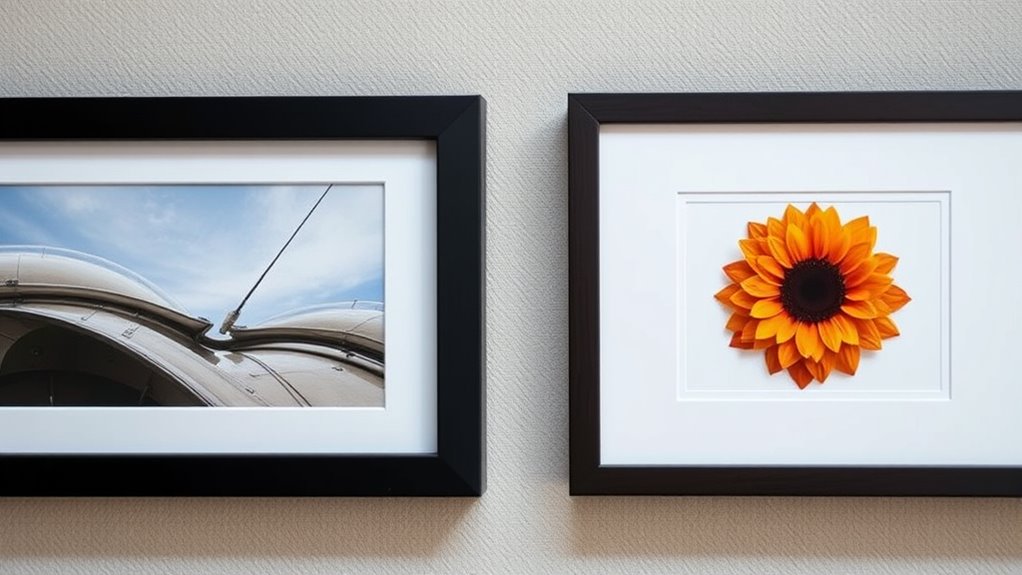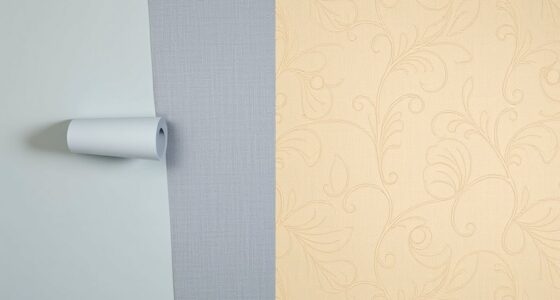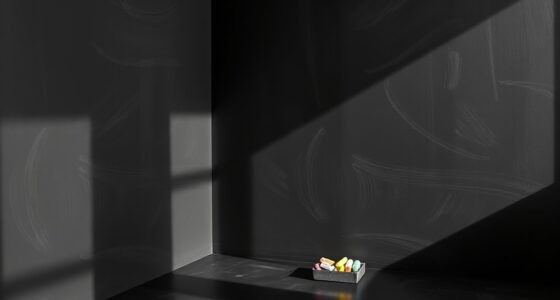Float mounting gives your artwork a sleek, modern look by creating the illusion it hovers on the wall, highlighting details and adding depth with strategic lighting. In contrast, matting provides a classic, framed appearance that offers better protection from environmental factors and allows for easier adjustments. Your choice affects the visual impact, protection, and flexibility of display, helping you achieve your desired aesthetic. Exploring further reveals how these options suit different spaces and needs.
Key Takeaways
- Float mounting offers a modern, sleek appearance with a sense of depth, while matting provides a classic, framed look emphasizing the artwork.
- Float mounting emphasizes the artwork’s edges and details, enhancing visual impact, whereas matting creates a border that separates artwork from the frame.
- Float mounting is more flexible and adjustable for lighting and repositioning; matting offers stability but is less adaptable for quick changes.
- Cost and installation complexity are generally higher for float mounting due to specialized hardware, while matting is simpler and more economical.
- The purpose of float mounting is to create a contemporary, dynamic presentation, whereas matting aims for protection and traditional aesthetic enhancement.
Visual Impact and Aesthetic Qualities
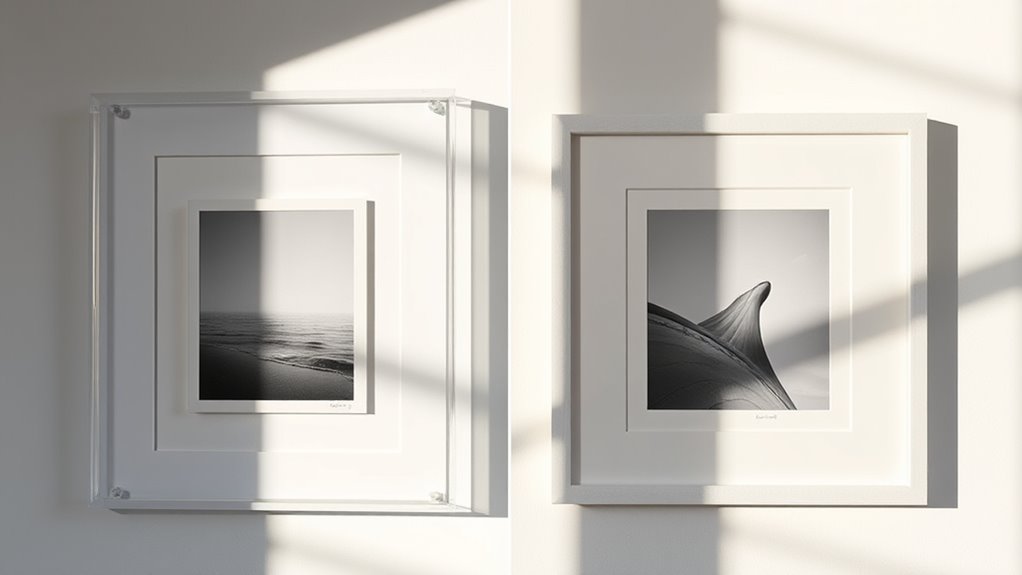
When it comes to visual impact and aesthetic qualities, floating mounts often create a sleek, modern look that appears to almost hover on the wall, drawing immediate attention. This design allows the artwork or photograph to stand out, emphasized by strategic lighting effects that highlight details and add depth. The clean, minimal border of floating mounts directs focus inward, enhancing viewer engagement without distractions. As light interacts with the edges and surface, it can produce subtle shadows or reflections that deepen the visual experience. This contemporary presentation appeals to those seeking a polished, sophisticated ambiance. Overall, floating mounts elevate the artwork’s presence, making a bold statement and encouraging viewers to connect more deeply with what’s displayed. Proper framing can further enhance the overall aesthetic, ensuring the artwork looks professionally presented and visually appealing. Additionally, choosing the right display method can significantly influence how the artwork is perceived and appreciated, especially when considering visual presentation techniques to maximize impact. Incorporating sustainable display options can also support eco-friendly practices in art presentation, aligning with a sustainable lifestyle.
Material and Construction Differences
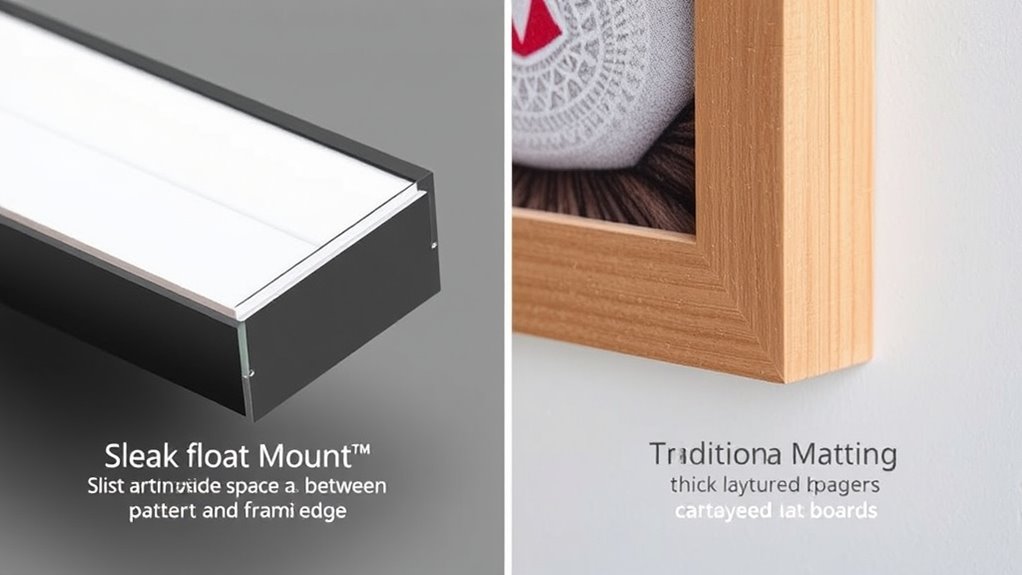
The materials and construction methods behind floating mounts and matting considerably influence their durability, appearance, and ease of installation. Floating mounts typically use sturdy backing materials like foam core or wood, combined with specialized mounting hardware that creates a seamless, three-dimensional look. In contrast, matting employs rigid backing materials such as foam board or cardboard, with mounting hardware that secures the artwork flat against the mat. Additionally, understanding the divorce statistics can help individuals appreciate the importance of choosing the right presentation method for their artwork. Selecting the appropriate mounting technique can also impact the moisture control, which is vital for preserving various types of artwork over time. Proper consideration of material durability ensures that artworks remain protected and visually appealing for years to come.
Suitable Environments and Settings
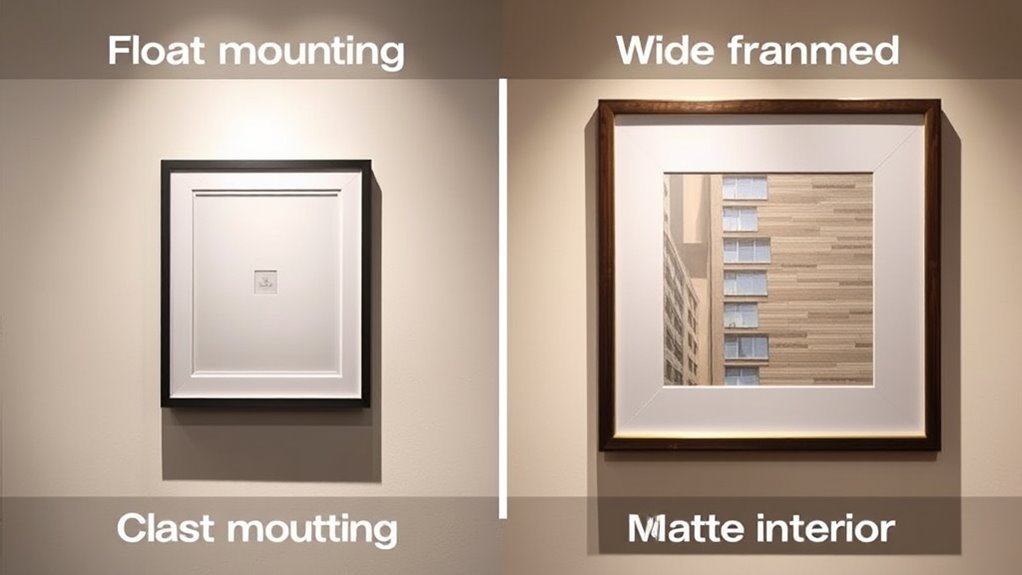
Choosing between floating mounts and matting depends considerably on the environment where your artwork will be displayed. Lighting considerations are essential; floating mounts often work well in well-lit spaces because they create shadows that enhance depth, but direct sunlight can cause fading or damage. Matting provides a buffer that can protect artwork from environmental factors like moisture or temperature fluctuations. For example, environmental protection is crucial when selecting framing options in areas prone to humidity or temperature swings. Additionally, UV protection is important in environments with significant sunlight exposure to prevent fading over time. For environments with high humidity or extreme temperature changes, opt for the more durable option, typically floating mounts, which can withstand these conditions better. Moreover, understanding personality traits can help in choosing the most suitable framing style that complements the display setting and intended atmosphere. Conversely, if your setting involves controlled lighting and stable temperature, matting offers a refined look while still protecting your piece. It is also beneficial to consider the cost and maintenance associated with each option to ensure long-term satisfaction. Ultimately, assess your space’s lighting and environmental durability to choose the best framing method for longevity and visual impact.
Preservation and Protection of Artwork
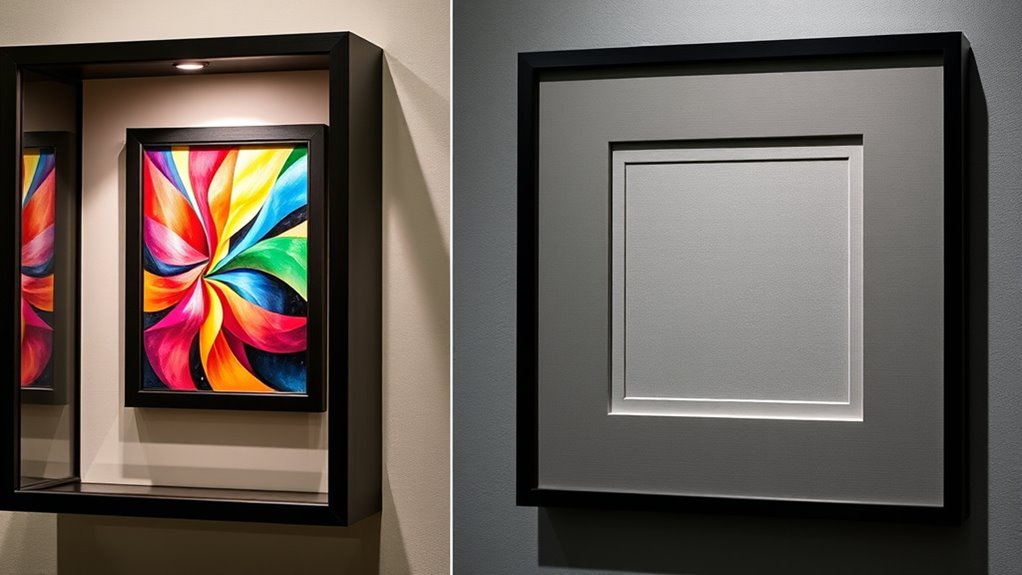
Proper preservation and protection of your artwork are vital for maintaining its value and appearance over time. You should regularly assess your piece for signs of damage and employ appropriate restoration techniques when needed. Using acid-free matting or mounting materials helps prevent deterioration caused by acidic substances. Lighting considerations are also essential; avoid direct sunlight and intense artificial lights that can fade colors or cause surface damage. Installing UV-filtering glass or acrylic provides additional protection against harmful rays. Keep your artwork in a stable environment with controlled humidity and temperature to prevent warping or mold growth. Additionally, choosing appropriate framing materials can further safeguard your artwork from environmental stressors. Incorporating environmental control techniques into your maintenance routine can help you stay attentive to your artwork’s needs and ensure its longevity. Regular monitoring of AI-driven environmental sensors can provide real-time data to maintain optimal conditions for your artwork. By proactively addressing these factors, you guarantee your artwork remains vibrant and intact for years to come.
Customization and Flexibility in Display
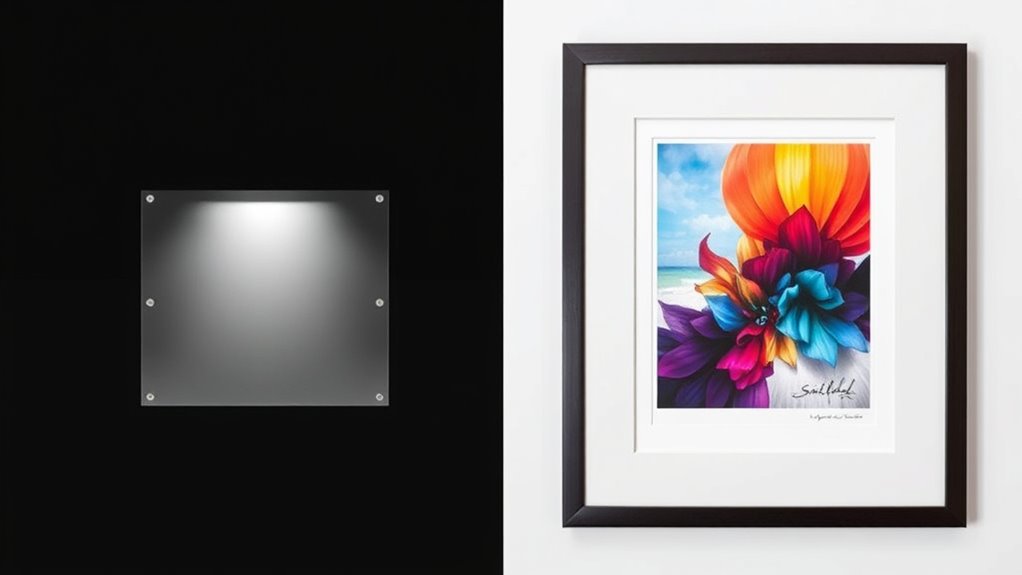
When choosing how to display your artwork, you’ll appreciate the design versatility options available with both float mounting and matting. These methods offer different levels of adjustability and reconfiguration, so you can easily update or change your display as needed. Incorporating display customization options can help you create a more dynamic and engaging showcase for your artwork. Additionally, considering the shelf life of materials can ensure your display remains in optimal condition over time. Proper selection and maintenance of display materials can also influence the production quantity variance of your exhibit setup, ensuring consistency and quality. Ultimately, your choice impacts how flexible and personalized your presentation can be.
Design Versatility Options
Both float mounting and matting offer distinct advantages when it comes to customizing your display, giving you the flexibility to tailor your presentation to suit your aesthetic preferences. Float mounting allows you to create striking lighting effects by adding depth and shadows, enhancing visual impact. It also offers a sleek, modern look that can be easily adapted to different artwork sizes and styles. Additionally, float mounting can help showcase the image quality by giving the artwork a sense of levitation and presence. Incorporating design versatility options through float mounting can further elevate the overall display. Matting, on the other hand, provides a traditional, polished appearance and can be customized with various colors, textures, and widths, adding character and focus. While float mounting typically involves less installation complexity, it requires careful handling to ensure proper alignment. Choosing the right mounting method can also influence the visual presentation and how the viewer perceives the artwork. Understanding the art display options can help you make an informed decision based on your aesthetic and practical needs.
Adjustability and Reconfiguration
Adjustability and reconfiguration are key factors to contemplate when choosing between float mounting and matting for your display. With float mounting, you gain easy access for adjusting lighting effects or re-positioning artwork without removing the piece entirely. Matting, on the other hand, offers more stability but may limit quick reconfiguration. Consider these points:
- Flexibility in changing lighting effects is more straightforward with float mounting, allowing dynamic displays.
- Security considerations favor matting for permanent setups, reducing accidental shifts or damage.
- Reconfiguration speed varies; float mounting enables quick updates, while matting often requires more effort to adjust or replace.
- Understanding different wall surface and finish options can help optimize the method you choose for durability and ease of adjustment.
Your choice depends on balancing the need for frequent reconfiguration against security and stability concerns.
Cost Considerations and Practical Aspects
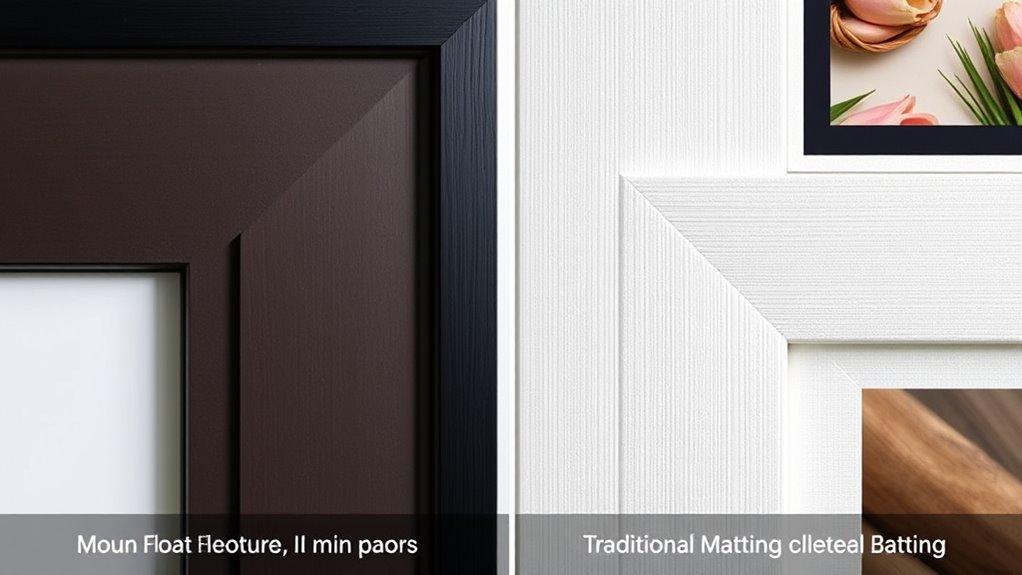
When comparing float mounting and matting, you’ll want to contemplate material and installation costs upfront. Think about how maintenance needs and the potential lifespan of each option could impact your long-term expenses. Understanding these practical aspects helps you make a cost-effective choice that fits your budget and needs. Additionally, considering the effectiveness of eye patches in enhancing appearance can inform your overall decision on display presentation and maintenance.
Material and Installation Costs
Material and installation costs play a significant role in choosing between float mounting and matting. Your decision impacts not only budget but also lighting effects and safety considerations. Typically, float mounting involves higher costs due to specialized hardware and precise installation, which enhances lighting effects by creating a sleek, modern look. Conversely, matting usually requires less material and simpler installation, reducing expenses. Consider these factors:
- Material expenses vary based on the type of backing and frame quality.
- Installation complexity influences labor costs and safety precautions.
- Additional costs may arise from required lighting adjustments to optimize visual impact.
Balancing these costs with safety considerations ensures your display remains both attractive and secure, making cost-effective choices essential for successful presentation.
Maintenance and Longevity
Maintenance and longevity considerably affect the overall value of your mounting choice. With float mounting, you’ll find that it often requires less upkeep since it avoids direct contact with surfaces, helping preserve lighting effects and security features over time. This method reduces dust accumulation and potential damage, extending the lifespan of your display. Matting, on the other hand, may need regular cleaning and occasional replacement to maintain its appearance and protection, which can increase long-term costs. Consider how each option fits your environment; float mounting’s minimal maintenance benefits may save you money and effort. Both methods should be evaluated for durability, ensuring your investment continues to enhance your space’s aesthetics and security features without frequent repairs.
Frequently Asked Questions
Which Mounting Method Offers Better Long-Term Durability?
Float mounting generally offers better long-term durability for artwork preservation. It keeps your art elevated, preventing contact with potentially damaging surfaces, which reduces wear over time. Plus, float mounting enhances mounting aesthetics by giving a modern, clean look that showcases the artwork’s edges. This method minimizes material contact, helping your piece stay intact longer. If longevity and maintaining the integrity of your art matter most, float mounting is the superior choice.
How Do Floating Mounts Affect Artwork Weight Limits?
Floating mounts can impact artwork weight limits by requiring sufficient mounting strength to support heavier pieces securely. You need to verify the floating frame or mount is rated for the artwork’s weight, as heavier artwork demands stronger, more durable mounting options. If you don’t, the mounting might fail over time, risking damage. Always check the specifications to match the artwork weight with the mount’s capacity, ensuring safe, long-lasting display.
Can Float Mounting Be Used for Irregularly Shaped Pieces?
You might wonder if float mounting works for irregularly shaped pieces—luckily, it does. This technique offers incredible artwork customization, seamlessly displaying even unconventional shapes with precision. The suspension creates a striking visual effect, enhancing display versatility. You’ll find float mounting adaptable, allowing you to highlight unique contours and textures without compromising stability. So, go ahead—embrace your art’s individuality and craft a mesmerizing, personalized presentation that truly stands out.
Is There a Difference in Mounting Time Between the Two?
Yes, there’s a difference in mounting time between float mounting and matting. Float mounting often takes longer because it offers greater artwork flexibility and requires precise positioning to achieve a clean, professional look. Matting is generally quicker, as it involves placing the artwork behind a pre-cut mat. If you seek a more refined, customizable presentation, expect increased installation complexity and time with float mounting.
How Do Mounting Methods Impact Resale or Appraisal Value?
They say a picture is worth a thousand words, and your mounting choice can speak volumes about value. Using float mounting or matting affects artwork preservation and enhances visual appeal, which collectors and appraisers notice. Proper mounting can boost resale or appraisal value by showing your commitment to quality and care. So, choose wisely, as your display method can make a lasting impression and add to your artwork’s overall worth.
Conclusion
Whether you choose float mounting or matting, think of each as a brushstroke shaping your artwork’s story. Float mounting creates a gallery-like levitation, making your piece dance in the light, while matting offers a soft, elegant frame that whispers timeless sophistication. Your choice sets the stage—like a custom frame for a treasured jewel—highlighting your art’s unique character. Ultimately, it’s your vision that transforms the display into a mesmerizing masterpiece.
